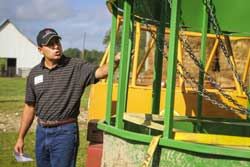|
What’s Best For The Producer
Wurdack Field Day To Feature Novel Fescue Trials And Educational Talks For Landowners
COOK STATION, MO.
Rough hair coats, low weight gain, fescue foot and less milk produced all are associated problems with fescue toxicosis. The disease in cattle has become a growing concern with many ranchers and is linked to Missouri’s most widely used forage crop – tall fescue.
The Kentucky 31 variety is famous due to its easy establishment and care as well as its tolerance to many insects and other diseases. But the prolific grower has a downside – a small endophyte fungus can develop that produces ergot-like complications.
“We have to look at different solutions to this tall fescue,” said Dusty Walter, superintendent of Wurdack Research Center. “One solution is the endophyte-free fescue varieties. However, history has shown these to be less durable than desired. New alternatives incorporate non-toxic endophytes. Wurdack has several new tall fescue selections established to assess their durability and grazing qualities.”
Results of the field trials and other educational presentations will be the highlight of the Wurdack Field Day on Oct. 3 at the center in Crawford County operated by the College of Agriculture, Food and Natural Resources (CAFNR) at the University of Missouri. Registration begins at 8:30 a.m. and free tours will run till noon and a complimentary lunch will be served.
“Our Field Day features a great lineup of talks for landowners of all kinds and worth coming out to spend the day hearing about the latest research,” added Walter. “We will also feature a lot about markets. Cattle prices are high right now and Scott Brown, MU agricultural and applied economics professor, will break down how we got here and what the future could look like for producers.”
Walter added that he has been impressed with the results from the new novel fescue varieties.

Justin Sexten, MU State Extension Beef Nutrition Specialist,
speaks to the crowd about reducing hay waste based on different
feeder selections at the 2013 Field Day.
“We converted the pastures just last year and already have hayed and grazed the fields,” said the superintendent. “Our analysis reports have shown good nutrient results, but more importantly, it is the things we have learned from this process. Our pastures are normal fields, just like you have out there. We’ve found out a lot about the management of these pastures to help producers. This is real-world knowledge.”
Additional presentations geared toward ranchers will include overviews of recent timed AI protocols, benefits of early pregnancy diagnosis and how hay sampling test results can be used for management strategies.
A hot topic across the country is the use of Unmanned Aerial Systems (UAS). MU specialists will give an update on the latest technology and policies affecting the use of UAS’s and how they can be used in agriculture.
“On the forestry side we will have a demonstration of a portable sawmill and overviews of the latest timber markets,” said Walter.
A talk by Tim Reinbott, Bradford Research Center superintendent, will emphasize other ways of using the land for added benefits including recycling and using common household waste in composting.
Wurdack Research Center is located at 164 Bales Road in Cook Station, 30 miles southeast of Rolla and 16 miles south of Steelville.
Visit the center’s new website at http://wurdack.cafnr.org for detailed directions, the latest research and real-time weather updates. Additional information can be found through the new CAFNR app, available free for Apple devices. Download today at http://app.cafnr.org/.
The Wurdack Research Center conducts demonstrations and research in integrated livestock, forages forestry and wildlife management practices that are economically viable, environmentally sound and sociologically acceptable for the Ozark region of Missouri. Nestled along the Meramec River near Cook, the farm is comprised of 1,200 acres — 260 acres of pastures and forage production — and acreage of predominantly upland hardwood forest. ∆
|
|